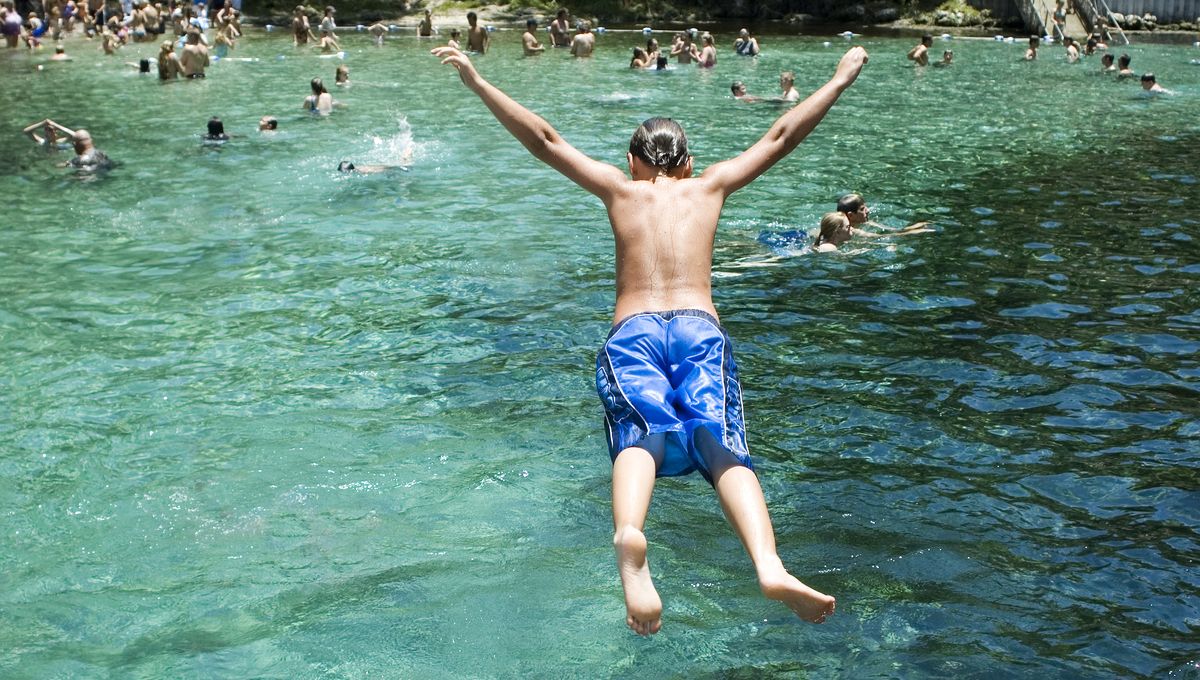
As anybody who’s ever got slightly tipsy near a pool, squinted up at a diving board, and thought to themselves, “I’ve seen the Olympics, it doesn’t look that hard,” can tell you, doing a belly flop into water can hurt. But have you ever wondered why that is? Well, grab some arnica gel and a pot of coffee: the answer involves more experimental physics and engineering than you might expect.
On the surface, so to speak, the science behind smashing tum-first into a pool is not that complex, noted Daniel Harris, assistant professor at Brown University’s School of Engineering and lead researcher on a new paper on belly flop mechanics. It’s simple Newtonian physics: “All of a sudden, the water has to accelerate to catch up to the speed of what’s falling through the air,” he explained in a statement. “When this happens, that large reaction force is sent back to whatever’s doing the impacting, leading to that signature slam.”
But just like the flop itself, this simplicity is followed by an inevitable sting. “Most of the work that’s been done in this space looks at rigid bodies slamming into the water, whose overall shape doesn’t really change or move in response to the impact,” Harris said. “The questions that we start to get at are: ‘What if the object that’s impacting is flexible so that once it feels the force it can either change shape or deform? How does that change the physics and then, more importantly, the forces that are felt on these structures?”
The problem is that the basic explanation only holds up if you’re extremely beefy. Outside of Marvel movies, humans tend to have a bit of give around the stomach area – and that little real-world addition, it turns out, can have some perplexing effects on the physics.
“Contrary to conventional intuition, we find that ‘softening’ the impactor does not always reduce the peak impact force,” the paper reveals. In fact, it “may also increase the force as compared with a fully rigid counterpart.”
So, how do you go about studying the science of belly flops? Sadly, the answer is less “massive intramural pool party”, and more “repeated experimentation based on painstaking mathematical modeling”. Using high-speed camera equipment and a system of sophisticated sensors, the team filmed a cylindrical mass being dropped into water and measured various outcomes on the body’s structural load.
So far, so standard – but what set Harris and his team’s experiments apart from many previous investigations was the addition of a soft impactor, attached by a system of flexible springs, to the end of the cylinder. It’s sort of like the suspension in a car, explained John Antolik, who led the study with Harris; the springs should, in theory, soften the impact of the mass by distributing the load over a longer period of time.
In practice, however, things were a little different.
“The structure is vibrating back and forth due to the violent impact,” said Harris. “So we were getting readings from both the impact of hitting the fluid and an oscillation because the structure is shaking itself.”
In other words: a more flexible flopper can sometimes result in a harder impact, not a softer one. So what gives?
The key, the team discovered, is in the springs – and getting it right is a tricky business. Too rigid, and the impact won’t be sufficiently absorbed; too soft, and you can end up adding extra vibrations to the system, increasing the overall force.
While the result may be of interest to dads on vacation, it’s even better news for the military and undersea researchers. Outside of poolside competitions, it’s naval and marine engineering that most often has a need for structures that can survive high-impact air-to-water slamming forces – and that’s why the research was partly funded by the Office of Naval Research and Naval Undersea Warfare Center.
But despite the high-tech nature of the result, it seems like nature may have solved the problem long ago – and indeed, the next steps for Harris and Antolik take inspiration from the graceful landings of certain diving birds.
“Biological studies of these birds have shown that they perform certain maneuvers as they enter the water to improve the conditions so they don’t experience such high forces,” Antolik said.
“What we’re moving towards is trying to design what is essentially a robotic impactor that can perform some active maneuver during water entry to do the same for blunt objects.”
The study is published in the Journal of Fluid Mechanics.
Source Link: This Is Why Belly Flops Hurt So Much